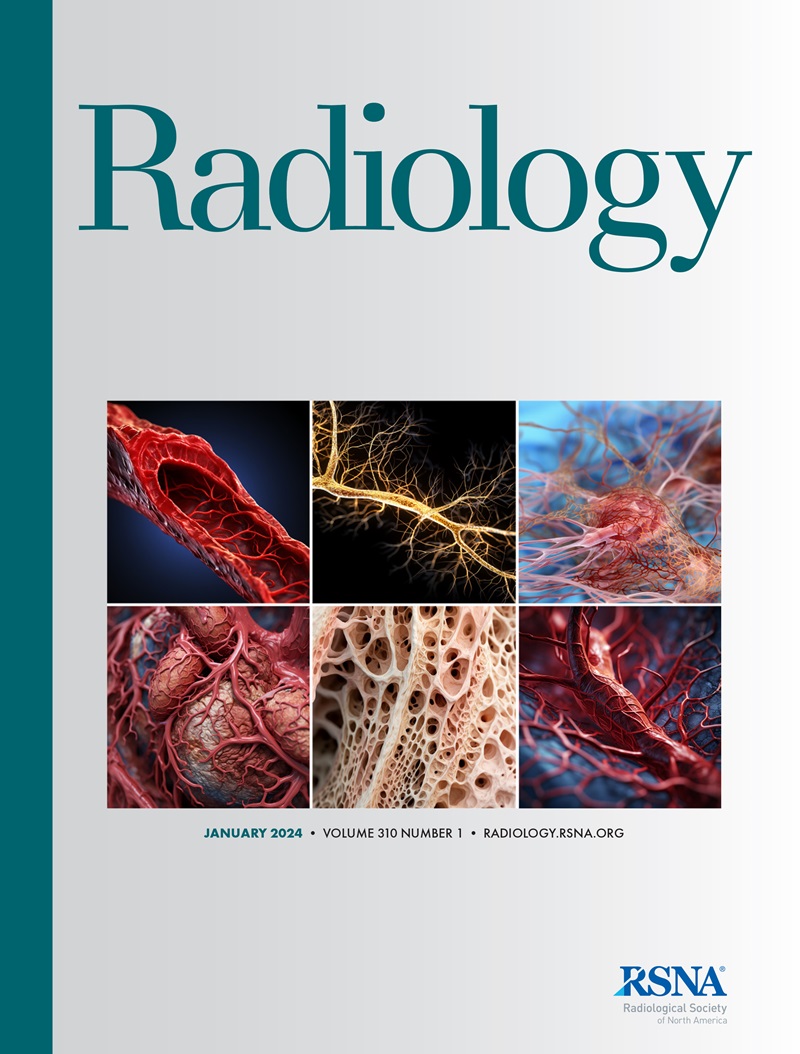Yan Zhuang, Tejas Sudharshan Mathai, Pritam Mukherjee, Brandon Khoury, Boah Kim, Benjamin Hou, Nusrat Rabbee, Abhinav Suri, Ronald M Summers
求助PDF
{"title":"MRISegmenter: A Fully Accurate and Robust Automated Multiorgan and Structure Segmentation Tool for T1-weighted Abdominal MRI.","authors":"Yan Zhuang, Tejas Sudharshan Mathai, Pritam Mukherjee, Brandon Khoury, Boah Kim, Benjamin Hou, Nusrat Rabbee, Abhinav Suri, Ronald M Summers","doi":"10.1148/radiol.241979","DOIUrl":null,"url":null,"abstract":"<p><p>Background There is a pressing demand to develop an automated segmentation tool for abdominal MRI that can provide accurate and robust segmentation in more than 60 abdominal organs and structures. Purpose To develop and evaluate the accuracy and robustness of an automated multiorgan and structure segmentation tool for T1-weighted abdominal MRI. Materials and Methods In this retrospective study, a T1-weighted abdominal MRI dataset composed of axial precontrast T1-weighted and contrast-enhanced T1-weighted arterial, portal venous, and delayed phases for each patient in a randomly selected sample was included at the National Institutes of Health Clinical Center. Each MRI series contained voxel-level annotations of 62 abdominal organs and structures. A three-dimensional segmentation (nnU-Net) model, called MRISegmenter, was trained on this dataset. This internal dataset was then randomly split into training and internal test sets. Evaluation was conducted on the internal test set and two external test sets (Abdominal Multi-Organ Segmentation Challenge 2022 [AMOS22] and Duke Liver). The predicted segmentations were compared against the radiologist-verified reference standard annotations using means ± SDs for the Dice similarity coefficient (Dice score) and normalized surface distance (NSD). The segmentation tool and dataset are publicly available at <i>https://github.com/rsummers11/MRISegmenter</i>. Results A total of 195 patients (training set, 135 patients [mean age, 54.7 years ± 16.3 {SD}; 72 male patients, 63 female patients]; internal test set, 60 patients [mean age, 51.1 years ± 14.4; 26 male patients, 34 female patients]) with 780 MRI scans containing 62 annotations each were included. On the internal test set, MRISegmenter achieved a mean Dice score of 0.861 ± 0.118 and a mean NSD of 0.924 ± 0.073. On external test sets AMOS22 (60 MRI scans) and Duke Liver (95 patients; 172 MRI scans), MRISegmenter attained a mean Dice score of 0.829 ± 0.133 and a mean NSD of 0.908 ± 0.067 and a mean Dice score of 0.933 ± 0.015 and a mean NSD of 0.929 ± 0.021, respectively. Conclusion MRISegmenter provided accurate and robust segmentation of 62 organs and structures at T1-weighted abdominal MRI. © RSNA, 2025 <i>Supplemental material is available for this article.</i> See also the editorial by Murphy in this issue.</p>","PeriodicalId":20896,"journal":{"name":"Radiology","volume":"315 1","pages":"e241979"},"PeriodicalIF":12.1000,"publicationDate":"2025-04-01","publicationTypes":"Journal Article","fieldsOfStudy":null,"isOpenAccess":false,"openAccessPdf":"","citationCount":"0","resultStr":null,"platform":"Semanticscholar","paperid":null,"PeriodicalName":"Radiology","FirstCategoryId":"3","ListUrlMain":"https://doi.org/10.1148/radiol.241979","RegionNum":1,"RegionCategory":"医学","ArticlePicture":[],"TitleCN":null,"AbstractTextCN":null,"PMCID":null,"EPubDate":"","PubModel":"","JCR":"Q1","JCRName":"RADIOLOGY, NUCLEAR MEDICINE & MEDICAL IMAGING","Score":null,"Total":0}
引用次数: 0
引用
批量引用
Abstract
Background There is a pressing demand to develop an automated segmentation tool for abdominal MRI that can provide accurate and robust segmentation in more than 60 abdominal organs and structures. Purpose To develop and evaluate the accuracy and robustness of an automated multiorgan and structure segmentation tool for T1-weighted abdominal MRI. Materials and Methods In this retrospective study, a T1-weighted abdominal MRI dataset composed of axial precontrast T1-weighted and contrast-enhanced T1-weighted arterial, portal venous, and delayed phases for each patient in a randomly selected sample was included at the National Institutes of Health Clinical Center. Each MRI series contained voxel-level annotations of 62 abdominal organs and structures. A three-dimensional segmentation (nnU-Net) model, called MRISegmenter, was trained on this dataset. This internal dataset was then randomly split into training and internal test sets. Evaluation was conducted on the internal test set and two external test sets (Abdominal Multi-Organ Segmentation Challenge 2022 [AMOS22] and Duke Liver). The predicted segmentations were compared against the radiologist-verified reference standard annotations using means ± SDs for the Dice similarity coefficient (Dice score) and normalized surface distance (NSD). The segmentation tool and dataset are publicly available at https://github.com/rsummers11/MRISegmenter . Results A total of 195 patients (training set, 135 patients [mean age, 54.7 years ± 16.3 {SD}; 72 male patients, 63 female patients]; internal test set, 60 patients [mean age, 51.1 years ± 14.4; 26 male patients, 34 female patients]) with 780 MRI scans containing 62 annotations each were included. On the internal test set, MRISegmenter achieved a mean Dice score of 0.861 ± 0.118 and a mean NSD of 0.924 ± 0.073. On external test sets AMOS22 (60 MRI scans) and Duke Liver (95 patients; 172 MRI scans), MRISegmenter attained a mean Dice score of 0.829 ± 0.133 and a mean NSD of 0.908 ± 0.067 and a mean Dice score of 0.933 ± 0.015 and a mean NSD of 0.929 ± 0.021, respectively. Conclusion MRISegmenter provided accurate and robust segmentation of 62 organs and structures at T1-weighted abdominal MRI. © RSNA, 2025 Supplemental material is available for this article. See also the editorial by Murphy in this issue.
mrissegmenter:一个完全准确和强大的自动化多器官和结构分割工具,用于t1加权腹部MRI。
目前迫切需要开发一种能够对60多种腹部器官和结构进行准确、稳健分割的腹部MRI自动分割工具。目的开发和评估用于t1加权腹部MRI的自动多器官和结构分割工具的准确性和鲁棒性。材料和方法在这项回顾性研究中,在美国国立卫生研究院临床中心随机选择的样本中,每个患者的t1加权腹部MRI数据集由轴向预对比t1加权和增强对比t1加权动脉、门静脉和延迟期组成。每个MRI序列包含62个腹部器官和结构的体素级注释。在此数据集上训练了一个称为MRISegmenter的三维分割(nnU-Net)模型。然后将这个内部数据集随机分成训练集和内部测试集。对内部测试集和两个外部测试集(腹部多器官分割挑战2022 [AMOS22]和杜克肝脏)进行评估。将预测的分割与放射科医生验证的参考标准注释进行比较,使用Dice相似系数(Dice score)的平均值±sd和归一化表面距离(NSD)。分割工具和数据集在https://github.com/rsummers11/MRISegmenter上公开可用。结果共195例患者(训练集),135例患者[平均年龄,54.7岁±16.3 {SD};男性72例,女性63例];内测组60例患者[平均年龄51.1岁±14.4岁;26名男性患者,34名女性患者]),共780张MRI扫描,每张扫描包含62条注释。在内部测试集上,MRISegmenter的平均Dice得分为0.861±0.118,平均NSD为0.924±0.073。外部测试装置AMOS22(60次MRI扫描)和Duke Liver(95例;MRI扫描172次),MRISegmenter的平均Dice评分为0.829±0.133,平均NSD为0.908±0.067,平均Dice评分为0.933±0.015,平均NSD为0.929±0.021。结论MRISegmenter在t1加权腹部MRI上对62个器官和结构进行了准确、稳健的分割。©RSNA, 2025本文可获得补充材料。参见墨菲在本期的社论。
本文章由计算机程序翻译,如有差异,请以英文原文为准。

 求助内容:
求助内容: 应助结果提醒方式:
应助结果提醒方式:


